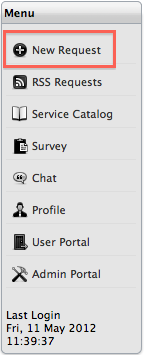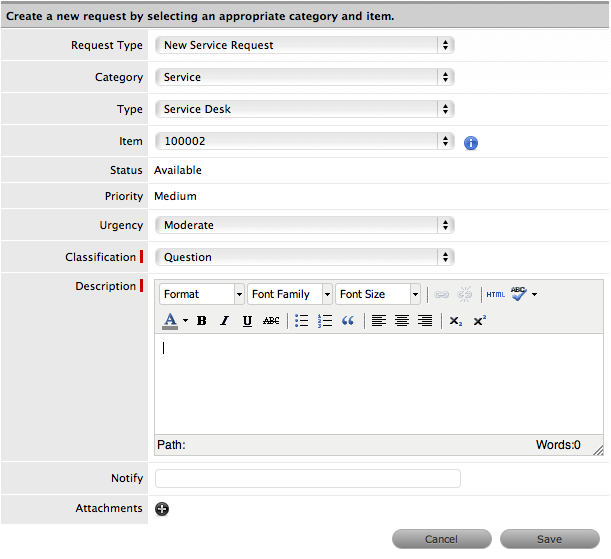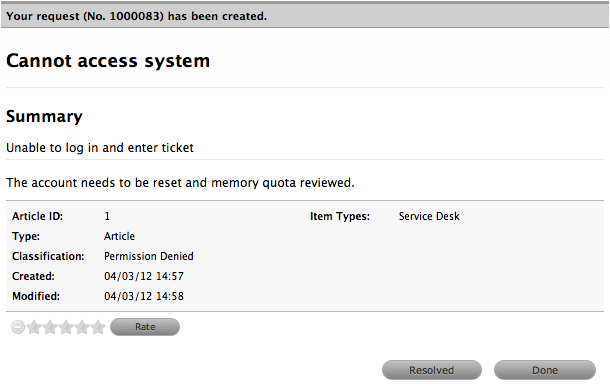Click New Request
from the Menu list
The New Request screen appears.

Customers have the option to enter their own requests using the Menu list in the Home and Request tabs, if the Create Requests option has been enabled within the Admin>Setup>Privileges>Customer tab.
As part of the request creation process, it should be noted that the Customer can only ever access Items and the details of Items that they own, have shared ownership or globally assigned Items (i.e., Items that are available to all Customers in the system). This means, that should they only own one Item and if there are no Global Items in the system, when they initiate the request creation process, the details of that one Item are automatically applied to the Request Type that is selected, without them having to select from drop-down lists.
However, if the system has the Show all Services option enabled in the Admin>Setup>Privileges>Customer tab, the Customer can view all Services offered by the Service Desk, regardless of the ownership status. It also means they can log a Service Request against any Service listed within the Services tab of the Customer Portal.
To create a new request:
Click New Request
from the Menu list
The New Request screen appears.

Select
the Request Type - Incident, Service Request or Change Request
Options displayed are based on the system configuration and if only
one option is available it will be automatically applied.

If Quick Call templates are available, they will appear in the Request Type drop-down list below the segmented line. In the image immediately above, it is the Password Reset request. Select this and the remaining details of the request are automatically completed based on the Template.
Enter an Item # ID to search for a specific Item (if the option has been enabled)
Select
an Item Category
The Category list is generated based on the Items that the Customer
is assigned within the system. The Item Type list is then displayed
relative to the Category selected.
Select
an Item Type
An Item list is generated based on the Item Type selected. The Item
list will consist of Items owned by the Customer and their Organizational
Unit, plus all globally assigned Items.
Select
an Item to assign to the request
Alternatively, select ![]() ,
if the option available, to create a new Item, see: Item
Creation.
,
if the option available, to create a new Item, see: Item
Creation.
The request editor is displayed in full.

If a Service Contract is required a message is displayed. See: Contracts
Select the Classification from the drop-down list provided
Enter
a Description to define the issue
This information is required to save the request.
Complete
the Notify field, if required
Enter email addresses for other
customers that are to be informed about the request. Multiple addresses
are to be separated by a comma.
If
relevant, click ![]() in the
Attachments field, to upload an associated file
in the
Attachments field, to upload an associated file
Note, at the point of request creation, only one attachment( maximum size 100 MB) can be
added. Once the request is saved to the database, multiple attachments
can be added in a single transaction.
Click
Save to enter the support request into the system
This will trigger the sending of an email message to the Customer and
to the Technician assigned to the request, if email polling is enabled
for the system.
![]()
Within the Thank You message, a list of possible helpful Knowledge Base Articles is presented to the Customer. This list is generated by the application based on the Description, Classification and Item assigned to the request.
The list presented includes an Article
ID number, Item Type, Classification and Summary columns. If relevant,
use the arrows at the base of the list to scroll through to the next list
screen.
To apply a Proposed Solution:
Click
on the Article No. hyperlink
The screen displays a summary of the Article.

Rate the Article, if desired
If
the Article was not helpful, click Done to return to the Article List.
If the Article resolves the issue, select the Resolved button and the
request will be closed.
